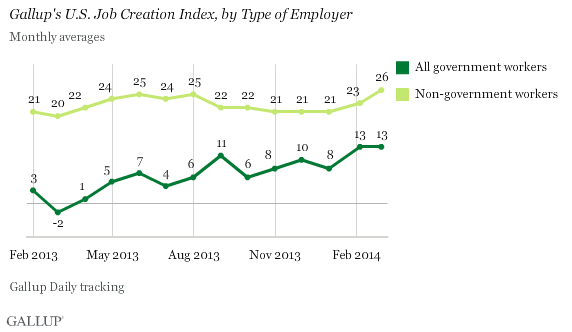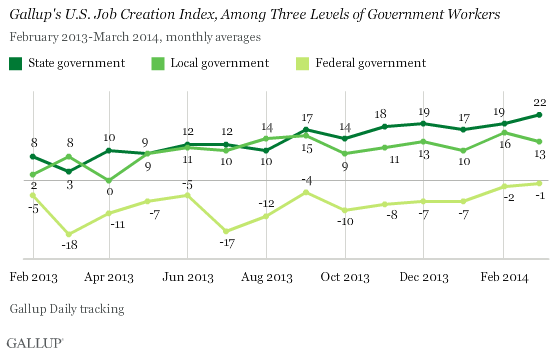WASHINGTON, D.C. -- Gallup's Job Creation Index, based on employee reports of hiring and layoff activity at their workplaces, reached a six-year high of +23 in March, nearly tying the +24 recorded in March 2008. The index for March is two points higher than it was in February, and shows a six-point improvement from last March.

The index was +26 in January 2008, when Gallup began Daily tracking of employee reports of hiring and layoff activity at their workplaces. Monthly averages began to plunge later that year as the economic recession worsened, eventually reaching negative territory and a monthly record low of -5 in February and April 2009. The index has recovered slowly since then, and is only now returning to levels seen when the recession began.
Gallup's Job Creation Index is a measure of net hiring activity in the U.S., with the monthly average based on a nationally representative sample of more than 17,000 full- and part-time workers last month. March's +23 index is based on 38% of U.S. workers saying their employer is hiring workers and expanding the size of its workforce, and 15% saying their employer is letting workers go and reducing the size of its workforce. Forty-two percent of workers in March said their employer is not changing the size of its workforce.

Non-Government Hiring Boosts the Index, While Government Hiring Remains Steady
Thirty-four percent of government workers in March reported that their employer was hiring workers and 21% said their employer was letting workers go. The resulting +13 Job Creation Index for government workers is unchanged from February, but five points higher than in January.
Meanwhile, 39% of non-government workers said their employer was hiring and 13% letting workers go, for an index score of +26. That is up three points from February, and the highest reading for non-government employment since Gallup began tracking it in mid-2008.

State Government Net Hiring Conditions Best on Record
State and local government workers continue to report a more positive hiring situation where they work than federal government workers do. Net hiring reached an all-time high of +22 among state government workers in March after mostly increasing over the past five months. Local government net hiring hit a record high in February, but leveled off at +13 in March.
Federal net hiring, at -1 in March, is inching closer to positive territory; the index for federal workers has been stuck in the negative zone since June 2011, but is up from -18 last March.

Bottom Line
U.S. workers in the private sector are reporting a more positive jobs situation where they work than at any point in the past six years. Combine this with state workers' record-high job creation reports and the year-over-year improvement from federal workers, and March's promising Job Creation Index reading would appear to be a positive sign in the long recovery from the 2007-2009 economic recession.
Survey Methods
Results for this Gallup poll are based on telephone interviews conducted March 1-31, 2014, on the Gallup Daily tracking survey, with a random sample of 17,371 employed adults, aged 18 and older, living in all 50 U.S. states and the District of Columbia.
For results based on the total sample of workers, the margin of sampling error is ±1 percentage point at the 95% confidence level.
Interviews are conducted with respondents on landline telephones and cellular phones, with interviews conducted in Spanish for respondents who are primarily Spanish-speaking. Each sample of national adults includes a minimum quota of 50% cellphone respondents and 50% landline respondents, with additional minimum quotas by time zone within region. Landline and cellular telephone numbers are selected using random-digit-dial methods. Landline respondents are chosen at random within each household on the basis of which member had the most recent birthday.
Samples are weighted to correct for unequal selection probability, nonresponse, and double coverage of landline and cell users in the two sampling frames. They are also weighted to match the national demographics of gender, age, race, Hispanic ethnicity, education, region, population density, and phone status (cellphone only/landline only/both, and cellphone mostly). Demographic weighting targets are based on the most recent Current Population Survey figures for the aged 18 and older U.S. population. Phone status targets are based on the most recent National Health Interview Survey. Population density targets are based on the most recent U.S. census. All reported margins of sampling error include the computed design effects for weighting.
In addition to sampling error, question wording and practical difficulties in conducting surveys can introduce error or bias into the findings of public opinion polls.
For more details on Gallup's polling methodology, visit www.gallup.com.
